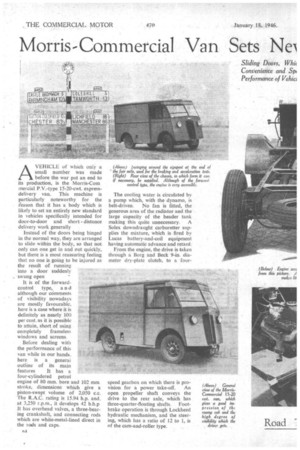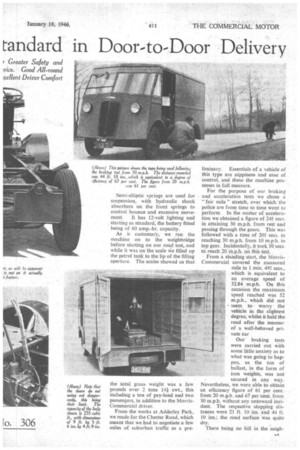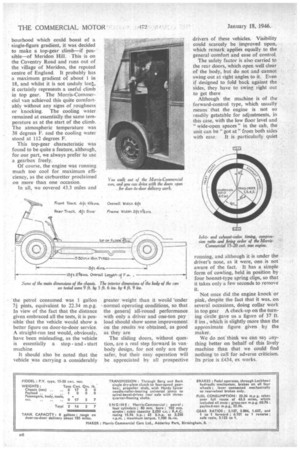Morris-Commercial Van Sets No rand ard in Door-to-Door Delivery
Page 30

Page 31

Page 32

If you've noticed an error in this article please click here to report it so we can fix it.
Sliding Doors, Whi( Convenience and Sp Performance of Vehio
r Greater Safety and tries. Good All-round :cellent Driver Comfort AVEHICLE of which only a small number was made before the war put an end to its production, is the Morris-Corn mercial P.V.-type 15-20-cwt. expressdelivery van. This machine is particularly noteworthy for the feason that it has a body which is likely to set an entirely new standard in vehicles specifically intended for door-to-door and short distance delivery work generally
Instead of the doors being hinged in the normal way, they are arranged to slide within the body, so that not only can one get in and out quickly, but there is a most reassuring feeling that no one is going to be injured as the result of running into a door suddenly , swung open . It is of the forward control type,. a n d although our comments of visibility nowadays are mostly favourable, here is a case where it is definitely as nearly 100 per cent. as it is possible to attain, short of using completely frameless windows and screens.
Before dealing with the performance of this van while in our hands. here is a generai outline of its main features It has a four-cylindered petrol engine of 80 mm. bore and 102 mm stroke, dimensions which give a piston-swept volume of 2,050 c.c. The R.A.C, rating is 15.94 h.p. and, at 3,250 r.p.m., it develops 42 b,h.p It has overhead valves, a three-bearing crankshaft, and connecting rods which are white-metal-lined direct in the iods and caps.
R4 The cooling water is circulated by a pump which, with the dynamo, is belt-driven. No fan is fitted, the generous area of the radiator and the large capacity of the header tank making this quite unnecessary. A Solex downdraught carburetter supplies the mixture, which is • fired by Lucas battery-and-coil equipment having automatic advance and retard.
From the engine, the drive is taken through a Borg and Beck 9-in, diameter dry-plate clutch, to a four speed gearbox on which there is pro vision for a power take-off. An open propeller shaft conveys the drive to the rear axle, which has
three-quarter-floating shafts. Footbrake operation is through Lockheed hydraulic mechanism, and the steering, which has a ratio of 12 to 1, is of the cam-and-roller type.
Semi-elliptic springs are used for suspension, with hydraulic shock absorbers on the front springs to control bounce and excessive move ment. It has 12-volt lighting and starting as standard, the battery fitted being of 60 amp.-hr. capacity.
As is customary, we ran the machine on to the weighbridge before starting on our road test, and while it was on the scale we filled up the petrol tank to the lip of the filling aperture. The scales showed us that the total gross weight was a few pounds over 2 tons 141 cwt., this including a ton of pay-load and two passengers, in addition to the MorrisCommercial driver.
From the works at Adderley Park, we made for the Chester Road, which meant that we had to negotiate a few miles of suburban traffic as a pre
liminary. Essentials of a vehicle of this type are nippiness and ease of control, and these the machine possesses in full measure.
For the purpose of our braking and acceleration tests we chose a "fair mile" stretch, over which the police are from time to time wont to perform. In the matter of acceleration we obtained a figure of 24* secs. in attaining 30 m.p.h. from rest and passing through the gears. This was followed with a time of 20t secs. in reaching 30 in,p,h. from 10 m.p.h. in top gear. Incidentally, it took 10 secs to. reach 20 m.p.h. on this test.
From a standing start, the MorrisCommercial covered the measured mile in 1 min, 491 secs., which is equivalent to an average speed of 32.84 m.p.h. On this occasion the maximum speed reached was 52 m.p.h., which did not seem to worry the vehicle in the slightest degree, whilst it held the road after the manner of a well-behaved private car
Our braking tests were carried out with some little anxiety as to what was going to happen, as the ton of ballast, in the form of iron weights, was not secured in any way. Nevertheless, we were able to obtain an efficiency figure of 61 per cent. from 20 m.p.h. and 67 per cent. from 30 m.p.h. without any untoward incident. The respective stopping distances were 21 ft. 10 ins. and 44 ft. 10 ins.; the road surface was quite dry.
There being no hill in the neigh bourhood which could boast of a single-figure gradient, it was decided to make a top-gear climb—if possible—of Meridon Hill. This is on the Coventry Road and runs out of the village of Meridon, the reputed centre of England. It probably has a maximum gradient of about 1 in 18, and whilst it is not unduly loq., it certainly represents a useful climb in top gear. The Morris-Commercial van achieved this quite comfortably without any signs of roughness or knocking. The cooling water remained at essentially the same temperature as at the start of the climb. The atmospheric temperature was 38 degrees F. and the cooling water stood at 112 degrees F.
This top-gear characteristic was found to be quite a feature, although, for our part, we always prefer to use a gearbox freely.
Of course, the engine was running much too cool for maximum efficiency, as the carburetter proclaimed on more than one occasion.
In all, we covered 43.3 miles and the petrol consumed was 1 gallon 71 pints, equivalent to 22.34 m.p.g. In view of the fact that the distance given embraced all the tests, it is possible that the vehicle would show a better figure on door-to-door service. A straight-run test would, obviously, have been misleading, as the vehicle is essentially a stop and start machine It should also be noted that the vehicle was carrying a considerably greater weight than it would 'under \ normal operating conditions, so that the general all-round performance with only a driver and one-ton pay load should show some improvement on the results we obtained, as good as they are The sliding doors, without question, are a real step forward in vanbody design, for not only are they safer, but their easy operation will be appreciated by all prospective drivers of these vehicles. Visibility could scarcely be improved upon, which remark applies equally to the general comfort and ease of control.
The safety factor is also carried to the rear doors, which open well clear of the body, but do not and cannot swing out at right angles to it. Even if designed to fold back against the sides, they have to swing right out to get there
Although the machine is of the forward-control type, which usually means that the engine is not so readily getatable for adjustments, in • this case, with the low floor level and "wide-open spaces" in the cab, the unit can be "got at" from both sides with ease, It is particularly quiet running, and although it is under the driver's nose, as it were, one is not aware of the fact. It has a simple form of cowling, held in position by four bonnet-type spring clips, so that it takes only a few seconds to remove it.
Not once did the engine knock or pink, despite the fact that it was, on several occasions, doing collar work in top gear A check-up on the turning circle gave us a figure of 37 ft. 8 ins, which is slightly more than the approximate figure given by the maker.
We do not think we can say ;mything better on behalf of this lively machine than that we could find nothing to call for adverse criticism. Its price is £434, ex works.




























































